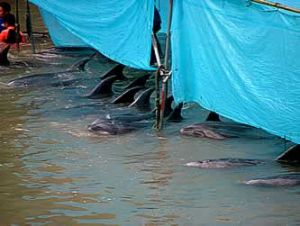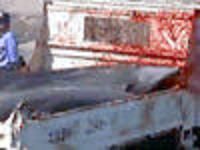DOLPHINMOTION
|  |
|
selection by people from the aquarium |
|
Dolphinmotion is founded to get awarenes for the 30.000 dolphins killed arround the world each year.
23.000 of these dolphins are killed in Japan.
Japanese believe dolphins eat all their fish.
Like all over the world this is due to the extencive fishery.
The main reason though is the trade in dolphins all over the world, where they are used in swimming with dolphin programs or show.
Dolphins need help! Biologist are worried.
More and more ocean species are on the list of threatened.
The polution of the oceans, extensive fishing industrie and this kind of slaughter make this a critical situation.
UNITED NATIONS
In 2007 the United Nations announced that year to be "the Year of the Dolphin".
Their goal was to make sure dolphins are protected worldwide, but also to let the world know about the alarming situation concerning dolphins.
Inspite the CITES (Convention on International Trade in Endangered Species of Wild Fauna and Flora) there is still a trade in dolphins captured from the wild.
DOLPHIN HUNT
Especially in Japan, where large pods of dolphins migrate along the coast, dolphin hunting is common sight. Around the end of september the drive hunt starts, killing 23.000 dolphins during a horrific slaughter.
Some of the dolphins survive, mostly the young, beautiful and untouched females. The majority of those will live the rest of their life in a concrete basin. A living dolphin will raise around 50,000 to 154,000 US dollar. They are sold to entertainment parks, aquariums and tourist attractions where they swim with dolphins. This industry is still growing it being a big reason for this cruel slaughter to take place.
Each year the dolphins are driven together in a shallow bay. The hunters do this by using metal sticks that create a horrible noise under water so the dolphins will flee in the direction the hunters want. The dolphin's sonar is disturbed by the sounds and the dolphins panic. After the pods are gathered in the bay the bay is closed of by nets.
Tens of dolphins are deliberately wounded by spears in order to disable their swimming abilities. The wounded dolphins won't be able to swim away and the other dolphins won't leave their wounded family family, so the pod stays together becoming an easy prey for the merciless hunters. The highly intelligent and social complex dolphins can't see the nets as the water is turbid. During this horrendous hunt a lot of dolphins die tangled in the nets or the suffocate in the shallow waters.
The next day the living dolphins are driven to the beach where people from aquariums are standing by to pick the best dolphins. Again during this dry the animals panic and huge numbers drowns. The dolphins scream loudly during this process: baby dolphins who've lost their mothers, mothers crying for their young and suffering dying dolphins.
After the selection process the 'left-over' dolphins are dragged out the water on chains and loaded on trucks. They are taken to slaughterhouses where the arrive most of the times alive. A dolphin has lungs and won't -unlike fish- immediately die when it comes out of the water.
The gravity effects their bodies immensely causing incredible pain. In the slaughterhouse the poor dolphins are dumped on the floors, their throats are cut and left to bleed to death.
Click here to view for more on dolphin trade and the swimming with dolphin programs.
DOLPHIN MEAT
Dolphin meat (and whale meat) is not popular at all in Japan.
A lot of Japanese people are admirers of nature and wouldn't even consider eating the meat of these beautiful creatures.
The pet industry in Japan is one of the largest in the world, with an annual revenue of 8 billion dollars. As the consumers leave dolphin meat about 70 percent of dolphin meat ends up in the petfood.
HEAVY METALS
|  |
|
Dolphins on a pick-up. |
|
Whale meat, just like dolphin meat and fat fish contain high amounts of heavy metals. They are stored in fat. Especially young children and our next generations are vulnerable. Around 1950 in the Japanese fishing village Minamata thousands of people become ill, handicapped or died because of the pollution of their seawater with heavy metals causes by a nearby factory.
In 2006 scientist revealed that dolphin meat contains sometimes over 30 percent more heavy metals then the tolerated percentage. The current concentration in dolphin meat is much higher then heavy metals in the fish around Minamata. At first activist where joyed by this announcement, but in Taiji dolphin slaughter remained one of their main activities, they people of Taiji are even building a new slaughterhouse to promote their dolphin meat.
The risks of tuna, dolphin and whale meat? Click here.
CULTURE
The problem is not the fact that the Japanese government claims dolphin hunt is part of their culture, it is the government who support the majority of the dolphin (and whale) hunt. The Japanese are being kept ignorant by their own government. The media barely reports about the cruel hunting issues. All that needs to change is the level of awareness in Japan.
A Japanese minister once said: "If the head of Toyota asks us to do something, we listen; whalers are really a minor force by comparison."
FAEROER
Every summer, not far from us, one of the most horrific crimes against pilot whales takes place.
It happens on the Faeroer a remote province Island group of Denmark.
These incredible kind species of dolphins where once hunted to supply the local people with food.
Nowadays the barbaric hunt has become a ritual for young men to show their masculinity.
For people who can not believe this is happening in Europe, click here for the footage.
CAMPAIGN BUS
The campaignbus of dolphinmotion will drive around the Netherlands to create awareness about the dolphin hunt.
It is hard for people in the West to realise what happens in Japan.
Therefor it is Dolphinmotion's goal to cooperate with a local action group in Japan.
Dolphinmotion eventually wants to bring the campaign bus to Japan.
The bus will soon be ready, but for now a 'sneak peak' of the 'Dolphinmotion bus'
WHAT YOU CAN DO!
- become a supporter or donate
- buy a T-shirt
- sponsor one of our air balloons.
What else can you!
Use your voice for "The Voiceless", sign the petition.
Write a letter to the Japanese embassy and show your concern.
You might even want to write Toyota!
Thank you very much and perhaps see you later in the Dolphinmotion Bus!
Address Japanese embassy in the Netherlands:
Tobias Asserlaan 2
25 KC Den Haag
Tel: 070-3469544.
|
| |
| T-shirts |
|
 |
| De T-shirts zijn binnen!
U kunt deze hier bestellen. |
|
|
| Hosting & programmering: |
|
 |
| Vormgeving in samenwerking met moonsenses. |
|
 |
|